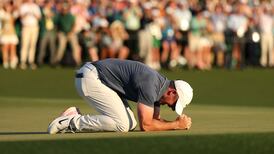Yes, people in Ireland like talking about the weather, inhaling the forecasts like oxygen on even the most nondescript of days. But as ex-Hurricane Ophelia approached off the southwest coast of Ireland on Sunday, we didn't just want to know the latest updates, we needed to know them. So how did we use various media and what did we learn from the coverage?
Extreme weather is more heavily consumed than election results
On Monday, IrishTimes.com disabled its subscription meter, giving users unlimited access to the site. This, combined with that need-to-know nature of the news, resulted in record levels of traffic on the site, with 3.6 million page views far exceeding the 2.6 million recorded on the weekend of the general election count in February 2016.
The RTÉ Nine O'Clock News on Sunday night (not long after the Status Red warning was extended across the State) attracted an average audience of 845,000 people across the whole bulletin. This was also well ahead of the most watched news programme in 2016, the 9pm bulletin on the Saturday of the election count, which attracted 721,000 viewers.
RTÉ's Monday broadcast of Liveline on RTÉ One and the afternoon news special presented by Bryan Dobson both attracted more than 500,000 viewers on average - huge ratings for a weekday afternoon - while the extended Six-One had an average of 717,000 viewers.
There is logic in the chronological. (This one’s for you, Twitter)
Storm Ophelia, as the meteorologists kept telling us, was a one-day event… except on Twitter. The once-linear social media platform is now horribly non-chronological. Serving up day-old tweets again and again is annoying at the best of times, but on Tuesday, it was especially pointless as the storm had passed and we were all back at work. Sadly, Twitter seems unlikely to deactivate this Facebook-esque algorithm because it believes it broadens the appeal of the platform and never mind that it actually spoils it for long-time users.
It’s a shame, because Twitter’s big strength is the ability to deliver real-time information faster than other platforms, as it did while those hurricane-force winds were hovering off the coast. Just a word here about hashtags: they’re not just there for decoration. They’re searchable. That’s why it was potentially important, especially for official emergency service accounts, to tag their tweets #Ophelia and not #Opehila or #Opheila.
Met Éireann’s Joanna Donnelly is suddenly a lot more well-known
While Evelyn Cusack was busy representing Met Éireann at the National Emergency Coordination Committee press conferences, Joanna Donnelly was the forecaster on air on RTÉ One on Monday and also on Sunday night, when her blunt warnings about the strength of Ophelia's winds will have swayed torn minds in the direction of staying at home.
A meteorologist for 14 years, Donnelly has only been on RTÉ Television since last year, but she has certainly proved herself as a highly effective communicator, issuing a stream of clear and direct updates and offering concise explanations of this unusual meteorological phenomenon. This prompted the Irish Independent to dub her the "face" of Ophelia.
A special mention also goes to TV3's Deric Ó h'Artagáin for being in his element while braving the elements on Ireland AM.
What do you mean you don’t have a battery-powered radio?
It’s a safe bet that with so many shops closed, newspaper sales won’t have fared well on Monday. But one traditional medium will have come into its own. Anyone unlucky enough to have had their electricity cut-off by Ophelia won’t have been able to watch any of the television coverage, and if their phone network was also down, then the internet won’t have been much use either. Enter that 20th century household item that is actually a little awkward to buy in shops these days: a battery-powered radio.
When everything a million times more modern is at the mercy of fallen power lines and damaged cables and masts, the kind of radio set that Pat Kenny once imagined might be found on the high shelf of a milking parlour "covered in a fine layer of congealed cow shit" will prove an entertainment / information lifeline as the winds whip up outside.
Weather is a visual story - but there are risks attached
We are lucky in Ireland that life-threatening weather events like Storm Ophelia do not happen often. But when they do, the potential for dramatic imagery is as high as the waves that crash ashore.
This poses a dilemma. Media organisations want to capture that imagery to tell the story of the storm, but they shouldn’t either put the lives of their staff at risk or be seen to do so. Nothing like this really happened on Monday, it seems, but it is a dubious trend to watch out for: in the US, television networks often seem to be competing to put their reporters in the midst of horrendous conditions so that their suffering becomes a near-comical spectacle in itself.
Equally, in the age of user-generated content, the ability to capture startling images and videos can prove fatally tempting. Professional journalists acknowledge the danger when they contact social media users to obtain permission for their footage, starting their messages with breezy “hope you’re safe” inquiries before getting down to business. But it should go without saying that no viral is worth the risk of death or injury.
In summary
An important job well done, with the obvious exception of anyone who trolled us by asking Danny Healy-Rae for his thoughts on climate change. Still... don’t take unnecessary journeys.














